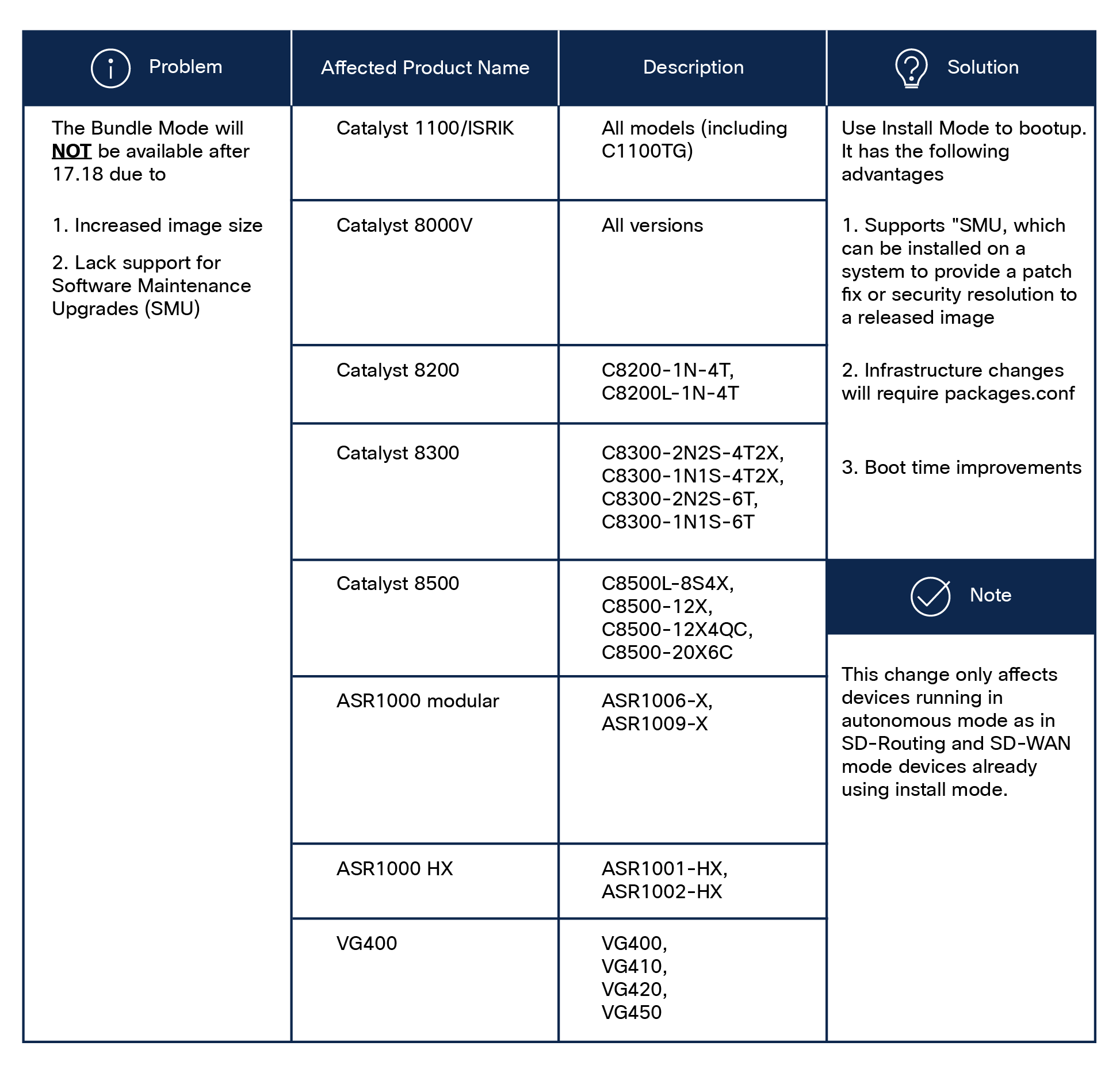Cisco IOS XE Bundle Boot Mode Will Be Discontinued After Release 17.18 – Product Bulletin
Available Languages
Bias-Free Language
The documentation set for this product strives to use bias-free language. For the purposes of this documentation set, bias-free is defined as language that does not imply discrimination based on age, disability, gender, racial identity, ethnic identity, sexual orientation, socioeconomic status, and intersectionality. Exceptions may be present in the documentation due to language that is hardcoded in the user interfaces of the product software, language used based on RFP documentation, or language that is used by a referenced third-party product. Learn more about how Cisco is using Inclusive Language.
When installing Cisco IOS® XE on a device, there are two options for installation and boot: Install Mode and Bundle Mode. After Release 17.18. Bundle Mode (.bin file) will be discontinued, and Install Mode (packages.conf file) will be the only option supported.
Bundle Mode is the mode when .bin file is copied to the flash and gets loaded to the memory directly. Bundle Mode requires the entire .bin file to be loaded into the device’s RAM to be unpacked and thus presents technical constraints as the .bin file size grows with new features. As more new capabilities are added to Cisco IOS XE, it is becoming increasingly infeasible to mitigate those technical constraints with Bundle Mode. Install Mode uses a different installation method that does not require the entire .bin file to be loaded into RAM. Install Mode also enables other capabilities such as Software Maintenance Upgrade (SMU) patching not available in Bundle Mode. Cisco recommends that customers migrate their devices to Install Mode as soon as it is convenient.
Install Mode is the mode when the image is extracted in flash and device loads packages.conf file to the memory. Install Mode is used by Cisco Catalyst™ SD-WAN today and by most Catalyst switch installations. Starting with Cisco IOS XE Release 17.15.1, all new products shipped with Cisco IOS XE installed in manufacturing will be configured with Install Mode by default. Customers are encouraged to start the transition to Install Mode as soon as practical.

Problem, solution, and platforms affected
Note: Additional product names will be added in the future as required. Check with your local sales teams if you have questions on other supported IOS XE products. If certain models reach end of sale prior to or past Release 17.18, those models will not be affected.
* An SMU (SMU description) is a package that can be installed on a system to provide a patch fix or security resolution to a released image. SMU patching is available only in packages.conf (starting in Cisco IOS XE Release17.9.1) and supported only with Install Mode. Customers using Bundle Mode are not able to take advantage of SMUs.
Traditionally, Cisco IOS XE has always supported Bundle Mode for packaging and for booting up. Install Mode is a newer mode introduced in Cisco IOS XE Release 17.9.1. Once an image is downloaded, customers have the option of installing using either mode. To help ensure that new features are available, Cisco is discontinuing Bundle Mode after Release 17.18.
Install Mode is the more modern method and is the mode recommended by Cisco. The .bin gets broken into smaller package files (.pkg files) and extracted into flash using an install command and loaded into memory independently of each other. Packages.conf is like an index/ pointer to all these .pkg files and uses the packages.conf file to boot the system. When the device boots up, this .conf file is opened to load the needed .pkg files, thereby using less RAM memory compared to bundle boot mode. This allows for faster boot times and better memory utilization. One caveat: Install Mode does not support boot from USB flash or TFTP.
Customers and partners are encouraged to migrate to Install Mode on or before Release 17.15.1. This will provide ample time to complete the transition before Bundle Mode is discontinued.
Download instructions (External)
Refer to the following link on Information About Installing the Software Using install Commands: https://www.cisco.com/c/en/us/td/docs/routers/cloud_edge/c8500/software-configuration-guide/c8500-software-config-guide/Package_Management-1.html#Cisco_Concept.dita_db8b7551-55cd-4dbd-b39e-fa9811cfb460.